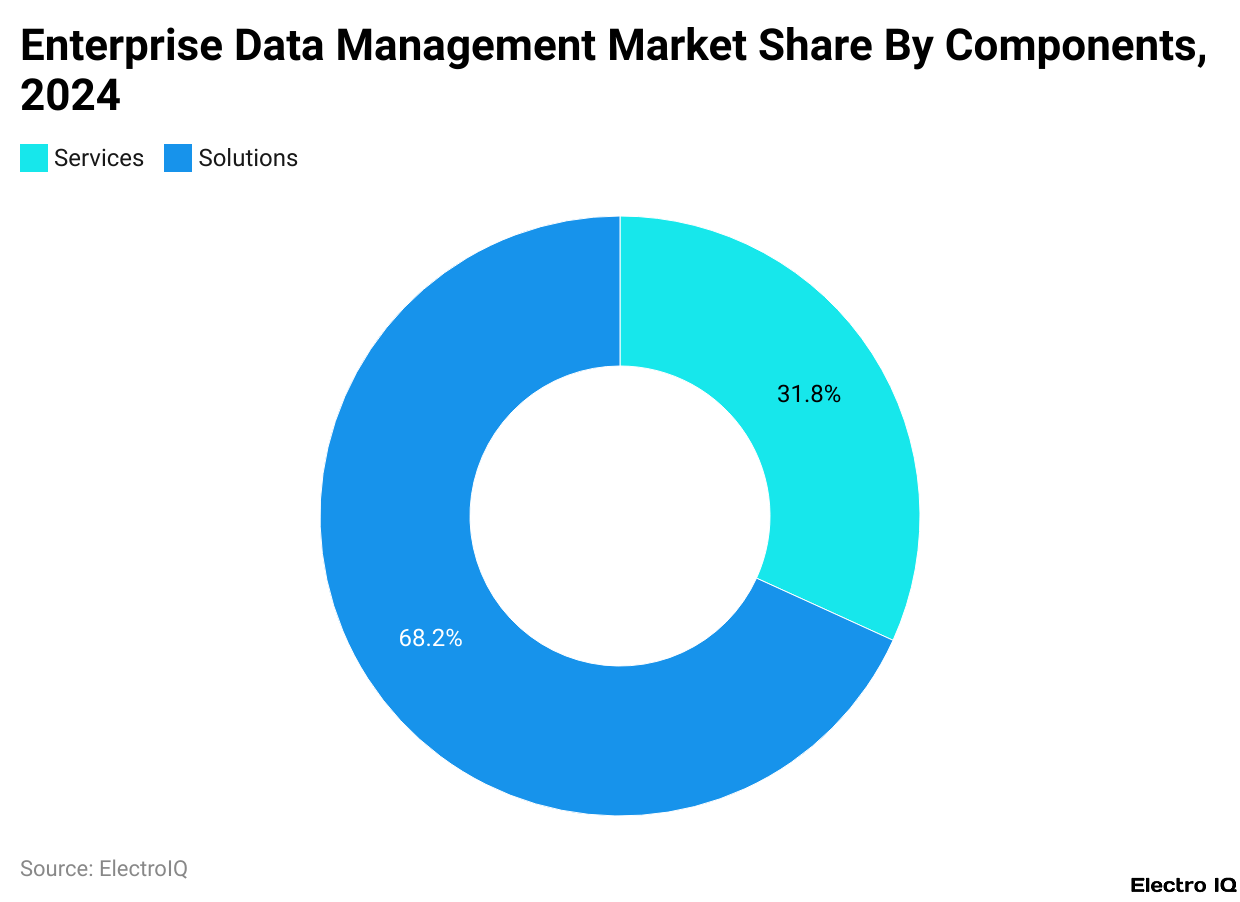Enterprise Data Management Statistics By Market Size, Usage and Facts (2025)
Updated · Sep 17, 2025

Table of Contents
Introduction
Enterprise Data Management Statistics: Enterprise Data Management (EDM) is the organization of working on the bigger setup to manage the collection, storage, cleaning, ensuring, and making of usable data. EDM went from a “nice to have” to a “must-have” in 2024 because companies need trusted data for AI technologies, compliance requirements, and day-to-day decisions. This article will show the key highlights of Enterprose Data Management statistics 2025.
Editor’s Choice
- The enterprise data management market was US$99.40 billion in 2023 and is expected to reach US$311 billion by 2033 at a 12.11% CAGR, being propelled by IoT, digitalization, and real-time data demands.
- Back in 2024, solutions accounted for 68.2% of revenue, while services are forecast to grow at a 24.5% CAGR through 2030, as organizations look to get assistance on hybrid integration, AI, and compliance.
- Larger enterprises hold 69.5% of the market as of 2023; cloud-based turns for 58.4%, testifying to the switch to scalable models.
- 43% of IT leaders emphasised storage costs as a major concern; 68% of data scientists spend over 4 hours identifying data incidents.
- Relational databases weigh heavily with a 72% share; Oracle leads worldwide with a 1244.08 popularity score.
- Global data creation will be 149 zettabytes in 2024, and 394 zettabytes in 2028, considering only a small chunk actually being retained.
- The EDM market in South Korea is set to grow at a CAGR of 6.2% (2024-2032), riding the wave of global growth.
- 90% of IT professionals say EDM practices are aligned with AI goals; only 37% feel “very aligned.”
- 87% want to implement AI, and 86% report their projects to be progressing well; 58% consider data quality and observability tools truly important.
- Come 2025, self-service data access, thousands of adoptions for all-flash storage, and AI-powered risk management will be powered to enhance efficiency, security, and resilience.
Enterprise Data Management Market Size
- The Global Enterprise Data Management Market was valued at USD 97.5 billion in 2023.

- By the end of 2024, the market is expected to reach a valuation of USD 108.4 billion.
- During the forecast period, the market is projected to record a CAGR of 11.2% and achieve a size of USD 281.9 billion by 2033.
- In 2023, the Software Segment dominated the market with a 77.9% share, due to the growing demand for robust data management platforms.
- Large Enterprises held a 69.5% share in 2023, although Small and Medium Enterprises (SMEs) are rapidly increasing their adoption of EDM solutions.
- In 2023, North America dominated the market with a 34.7% share, supported by strong technological infrastructure, regulatory compliance, and emphasis on data-driven strategies.
- The North American EDM market was valued at USD 33.8 billion in 2023 and is expected to witness significant growth during the forecast period.
- Leading companies in the EDM market include IBM Corporation, Oracle Corporation, SAP SE, Microsoft Corporation, SAS Institute Inc., and Amazon Web Services, Inc.
By Components

(Reference: mordorintelligence.com)
- As per Motor Intelligence, enterprise data management statistics state that Solutions, in 2024, represented the biggest share of revenue in the enterprise metadata management market, at about 68.2%.
- However, the focus on and importance of services is catching up and is estimated to grow at a healthy CAGR of 24.5% through 2030.
- This basically stems from most companies facing mounting levels of complexity in trying to integrate hybrid systems, adopt AI, and remain compliant with stiff regulations.
- Deutsche Telekom, for example, collaborated with Capgemini on a TMForum-aligned model that helped shorten product-launch cycles, clearly illustrating the value of service expertise.
- Externalized partners are also requested by enterprises to support them through their managed metadata operations, especially due to very frequent changes in privacy laws and cloud tools.
- This way, recurrent revenue opportunities can be created for system integrators and managed service providers.
- With cloud environments growing in size and complexity, many organisations are considering outcome-based service contracts, thus further stimulating the demand for advisory, implementation, and constant support services.
General Statistics
- Enterprise data management has long been witnessing a steady growth.
- Large enterprises take the majority of it, with a market share of 69.5% in 2023, while cloud-based solutions had 58.4% of the market, thus showing a true shift toward scalable and cost-effective deployment models.
- Software holds 77.9% of the market, though services are rapidly gaining ground as organisations grapple with integration, AI enablement, and compliance requirements.
- Data storage costs were considered the biggest hurdle by 43% of the IT decision-makers in 2023.
- Data professionals are also spending many hours firefighting: 68% say it takes longer than 4 hours to discover data incidents, an increase from 62% in 2022.
- Half of these professionals believe that teams tasked with data engineering share the biggest responsibility for ensuring data quality.
- On the database side, relational database management systems ruled, taking the market share of 72% of DBMSs as of December 2022.
- By mid-2024, Oracle held fame as the number one relational database in the world, registering a popularity score of 1244.08.
- Data creation, capture, and consumption worldwide is exploding, with an estimate of 149 zettabytes in 2024 and more than 394 zettabytes by 2028.
- Yet only a small portion of this data has been kept for the long term. For example, in 2020, just 2% of all data manufactured and consumed were stored in 2021.
- The South Korean market is expected to grow at a CAGR of 6.2% from 2024 to 2032, symbolising the spreading demand for data management across the globe.
- Almost 90% of surveyed IT professionals claimed that their data management procedure is either somewhat or fully aligned with the goals of AI.
- However, only about 37% say they are very aligned, so a large percentage of organizations know there is some work that needs to be done before they can fully support AI.
- Data literacy is key, with 90% of professionals saying that better literacy would impact AI success, with 40% of them saying significantly.
- Real-time information access is considered critical by some 65% of IT leaders.
- Overall, 87% of IT professionals would like to see the implementation of AI, with almost half indicating very strong intent to do so.
- In fact, 86% report significant progress on their AI projects, implying that most companies are already proceeding.
- To this, 58% opine that high-grade data, along with observability tooling, forms the foundation of reliability.
- Many of them cite culture building around data (61%), increasing awareness of data value (69%), and fostering cross-functional collaboration (66%) as other important means.
Latest Data Management Trends In 2025
- These days, in 2025, the evolution of data management continues as businesses focus on accessibility, agility, and defensive means.
- One big trend is making data widely accessible to foster understanding throughout the organization.
- Companies are providing data in easy-to-understand visual formats and enabling executives and staff with self-service tools so that they no longer need to rely on technical teams to dig out pertinent information.
- The centralized approach to dealing with data coming from different sources entails consistency improvements in data quality, which will enable people in the lower hierarchy to make knowledgeable decisions.
- This certainly encourages collaboration amongst people and further builds a data-driven culture that promotes innovation and the laying down of smarter strategies.
- Currently, flash storage is rapidly overtaking traditional hard disk drives because it offers over-the-top speed, reliability, and energy efficiency.
- Tasks that require speedy retrieval for application performance or file loading use response times in microseconds, whereas HDDs work in milliseconds.
- With no moving parts, flash storage is less prone to failures; hence, its usage is most appreciated in portable devices.
- It consumes less power and thus brings down charges in data centers and extends battery life in laptops. Due to fast, scalable storage demand, all-flash systems are becoming the norm.
- Ransomware attacks have been on the rise lately, not only draining companies of ransom payments but also costing them heavily in downtime loss, recovery costs, and reputational damage.
- The cost of recovery in the coming days is only growing, so businesses are strengthening their defense systems.
- To address threats, many organizations utilize artificial intelligence and machine learning.
- These technologies can analyze gigantic data sets, search for hidden patterns, and preempt possible risks from getting out of hand.
- They allow a real-time threat view and a quick response to new developments and can carry out risk assessments through automation to ensure precision and efficacy.
- With AI and ML technologies, companies can become proactive to reduce risk and fortify resilience in a data-driven future.
Conclusion
Enterprise Data Management Statistics: Enterprise Data Management (EDM) has gone from being an option to a critical necessity for contemporary businesses by 2024. Much has been said about the market being valued at US$99.40 billion in 2023 and expected to reach US$311 billion by 2033. Internet of Things, Artificial Intelligence, and Cloud are driving the market growth. Large enterprises take the lion’s share, but services are growing in momentum as companies seek assistance with integration, compliance, and AI-readiness.
Data concerns such as storage costs, incident detection, or ransomware threats will remain high, pushing companies towards smarter toolsets, better governance, and AI-driven risk management. Self-service access, flash storage, and AI-addressed security will be the mantra for EDM by 2025.
Sources
FAQ.
The EDM market was valued at US$99.40 billion in 2023 and is set to grow to US$311 billion by 2033, with a CAGR of 12.11%.
Solutions constitute 68.2% of the revenue in 2024, but services are growing fast, with the highest projected CAGR at 24.5% through the year 2030.
Challenges are high storage cost (43% of IT leaders), slow detection of incidents (68% of professionals take more than 4 hours).
In about 90% of cases, IT professionals say their practices are in alignment with AI, but only 37% say they are fully in alignment. AI is creating demand for improved data quality and observability.
Self-service data access, widespread all-flash storage adoption, and AI-driven risk management for speed, security, and decision-making.

I hold an MBA in Finance and Marketing, bringing a unique blend of business acumen and creative communication skills. With experience as a content in crafting statistical and research-backed content across multiple domains, including education, technology, product reviews, and company website analytics, I specialize in producing engaging, informative, and SEO-optimized content tailored to diverse audiences. My work bridges technical accuracy with compelling storytelling, helping brands educate, inform, and connect with their target markets.










